Roles of Arabidopsis cyclin-dependent kinase C complexes in cauliflower mosaic virus infection, plant growth, and development
- PMID: 17468259
- PMCID: PMC1913762
- DOI: 10.1105/tpc.107.051375
Roles of Arabidopsis cyclin-dependent kinase C complexes in cauliflower mosaic virus infection, plant growth, and development
Abstract
The C-terminal domain (CTD) of RNA polymerase II is phosphorylated during the transcription cycle by three cyclin-dependent kinases (CDKs): CDK7, CDK8, and CDK9. CDK9 and its interacting cyclin T partners belong to the positive transcription elongation factor b (P-TEFb) complexes, which phosphorylate the CTD to promote transcription elongation. We report that Arabidopsis thaliana CDK9-like proteins, CDKC;1 and CDKC;2, and their interacting cyclin T partners, CYCT1;4 and CYCT1;5, play important roles in infection with Cauliflower mosaic virus (CaMV). cdkc;2 and cyct1;5 knockout mutants are highly resistant and cdkc;2 cyct1;5 double mutants are extremely resistant to CaMV. The mutants respond normally to other types of plant viruses that do not replicate by reverse transcription. Expression of a reporter gene driven by the CaMV 35S promoter is markedly reduced in the cdkc;2 and cyct1;5 mutants, indicating that the kinase complexes are important for transcription from the viral promoter. Loss of function of CDKC;1/CDKC;2 or CYCT1;4/CYCT1;5 results in complete resistance to CaMV as well as altered leaf and flower growth, trichome development, and delayed flowering. These results establish Arabidopsis CDKC kinase complexes as important host targets of CaMV for transcriptional activation of viral genes and critical regulators of plant growth and development.
Figures

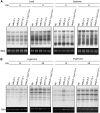
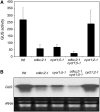
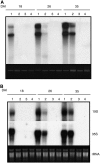

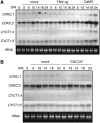
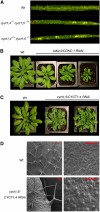
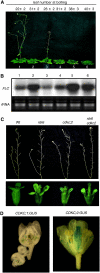
Similar articles
-
The Medicago CDKC;1-CYCLINT;1 kinase complex phosphorylates the carboxy-terminal domain of RNA polymerase II and promotes transcription.Plant J. 2005 Jun;42(6):810-20. doi: 10.1111/j.1365-313X.2005.02421.x. Plant J. 2005. PMID: 15941395
-
Altered patterns of gene expression in Arabidopsis elicited by cauliflower mosaic virus (CaMV) infection and by a CaMV gene VI transgene.Mol Plant Microbe Interact. 1999 May;12(5):377-84. doi: 10.1094/MPMI.1999.12.5.377. Mol Plant Microbe Interact. 1999. PMID: 10226370
-
Loss of CDKC;2 increases both cell division and drought tolerance in Arabidopsis thaliana.Plant J. 2017 Sep;91(5):816-828. doi: 10.1111/tpj.13609. Epub 2017 Jul 13. Plant J. 2017. PMID: 28622431
-
Regulatory functions of Cdk9 and of cyclin T1 in HIV tat transactivation pathway gene expression.J Cell Biochem. 1999 Dec 1;75(3):357-68. J Cell Biochem. 1999. PMID: 10536359 Review.
-
Cellular control of gene expression by T-type cyclin/CDK9 complexes.Gene. 2004 Aug 4;337:15-23. doi: 10.1016/j.gene.2004.05.007. Gene. 2004. PMID: 15276198 Review.
Cited by
-
The Arabidopsis SMALL AUXIN UP RNA32 Protein Regulates ABA-Mediated Responses to Drought Stress.Front Plant Sci. 2021 Mar 12;12:625493. doi: 10.3389/fpls.2021.625493. eCollection 2021. Front Plant Sci. 2021. PMID: 33777065 Free PMC article.
-
Drought adaptation in Arabidopsis thaliana by extensive genetic loss-of-function.Elife. 2018 Dec 6;7:e41038. doi: 10.7554/eLife.41038. Elife. 2018. PMID: 30520727 Free PMC article.
-
Arabidopsis S2Lb links AtCOMPASS-like and SDG2 activity in H3K4me3 independently from histone H2B monoubiquitination.Genome Biol. 2019 May 21;20(1):100. doi: 10.1186/s13059-019-1705-4. Genome Biol. 2019. PMID: 31113491 Free PMC article.
-
Proteomics and transcriptomics analyses of Arabidopsis floral buds uncover important functions of ARABIDOPSIS SKP1-LIKE1.BMC Plant Biol. 2016 Mar 3;16:61. doi: 10.1186/s12870-015-0571-9. BMC Plant Biol. 2016. PMID: 26940208 Free PMC article.
-
Genome-Wide Identification, Characterization, and Transcriptomic Analysis of the Cyclin Gene Family in Brassica rapa.Int J Mol Sci. 2022 Nov 13;23(22):14017. doi: 10.3390/ijms232214017. Int J Mol Sci. 2022. PMID: 36430495 Free PMC article.
References
-
- Adamson, T.E., Shutt, D.C., and Price, D.H. (2005). Functional coupling of cleavage and polyadenylation with transcription of mRNA. J. Biol. Chem. 280 32262–32271. - PubMed
-
- Akoulitchev, S., Chuikov, S., and Reinberg, D. (2000). TFIIH is negatively regulated by cdk8-containing mediator complexes. Nature 407 102–106. - PubMed
-
- Alonso, J.M., et al. (2003). Genome-wide insertional mutagenesis of Arabidopsis thaliana. Science 301 653–657. - PubMed
MeSH terms
Substances
LinkOut - more resources
Full Text Sources
Molecular Biology Databases
Research Materials
Miscellaneous

